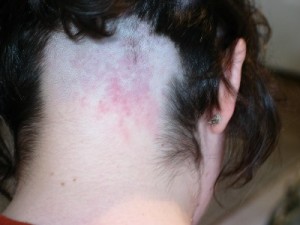UPDATE: After 18 years of severe chronic illness and disability, in 2013 I recovered my health using neural retraining. You can read my recovery story at sharonwachsler.com. Thanks.
There is no short answer to the question “What is Sharon’s disability?” because she has several, and there have been many changes (mostly additions and progressions) over the years.
Sharon was not born disabled. Just out of college, from 1992 though 1995, she unknowingly suffered a series of chemical injuries, culminating in several months of carbon monoxide poisoning. This damage left her with the chronic conditions multiple chemical sensitivity (MCS) and myalgic encephalopathy (ME) — as it is known everywhere except the US, where ME has the horribly misleading name of chronic fatigue syndrome (CFS), sometimes amended to chronic fatigue immune dysfunction syndrome (CFIDS).
In Sharon’s case, having ME/CFIDS means significant problems with cognition (memory, concentration, word retrieval); sleep abnormalities and insomnia; exhaustion, weakness, and poor stamina; and a constantly fluctuating and unpredictable set of flu-like symptoms. Sharon’s most successful strategy for managing ME/CFIDS has been to avoid, as much as possible, any mental, physical, or emotional “exertions” — as all lead to worsened function. Even with “aggressive resting,” Sharon’s function is severely affected. (Read more detailed information about how CFIDS affects Sharon.)
For Sharon, having MCS in the city meant not being able to open her windows or leave her home except with the use of oxygen, a filter mask, and an air purifier. Even with such precautions, exposure to chemicals from fragrances, cleaning products, construction materials, auto exhaust, and other pollutants was inevitable, and caused her to suffer a range of symptoms from hours to months after. Everything in her home environment had to be under strict control. (Read more detailed information here about how MCS affects Sharon.)
Due to her progressing MCS, in 1998, Sharon moved from Somerville, Mass., the most densely-populated city in New England, to a very rural area of Western Mass. This helped at first, because fewer people meant cleaner air. However, over time she developed increasingly frequent and severe migraines, until they typically lasted weeks at a time. Simultaneously, she seemed to develop mild fibromyalgia. (However, later events have led Sharon to rethink her diagnosis of fibromyalgia.)
In June of 2007, Sharon pulled a tick off the nape of her neck, and a few weeks later she found a rash indicating Lyme disease had appeared at the site:
She was confident that a course of antibiotics would put her right in a couple of months. However, over time she got worse, and eventually she learned that not only did she have chronic Lyme, but two other tick-borne diseases (TBDs or coinfections) that had gone untreated or undertreated for over a year. One is called babesiosis or babesia and the other bartonellosis or bartonella. This constellation of multiple TBDs led to new disabilities as well as severe worsening of the old ones, including impairment in speaking/loss of voice (vocal-cord apraxia), immobilizing body pain, loss of muscle strength and control, and new forms of cognitive, sensory, and neuropsychological dysfunction. The intense psychological symptoms Sharon suffered with for two years, before antimicrobial treatment took effect, destroyed many of her most important relationships, along with her sense of self.
A key blood test and the great reduction in migraines frequency after starting intensive antibiotic treatment have led Sharon and her doctors to believe she contracted a previous case of Lyme disease after moving to the country. It is likely that the so-called fibromyalgia, like the migraines, was actually untreated Lyme. But because Sharon had so many other symptoms explainable by her other diseases, and because she never exhibited the “classic” Lyme signs of rash or joint pain, TBDs went unrecognized until the second set of infections. (Read more of Sharon’s Lyme story here, and other posts on Lyme here.)
Sharon rarely has migraines anymore — the only really obvious symptom to have resolved with Lyme and coinfection treatments. When going on new antibiotics, often her migraines were decrease markedly, and eventually they became much less frequent. Since going through menopause at the age of 42, she now often goes weeks without a migraine. Her severe, chronic muscle and joint pain
Currently, Sharon is on oral, intramuscular, and intravenous antibiotics and antiparasitics, and requires pain medication to function. Most days she is on bedrest fulltime. On good days, she’s able to get around the house in her power wheelchair. Sharon needs assistance with activities of daily living and, when unable to speak, uses a combination of sign language, voicing, mouthing, and typing to communicate, depending on her own and the other person’s abilities. With aggressive treatment, she has gone through periods of great improvement; however, in the last two years she has worsened again. Further, one day’s exertion or exposure has sometimes caused her to relapse severely for months. Sharon looks forward to renewed and more enduring improvements in her health and functioning as her treatment continues.





